Kaiseki ryori is a traditional Japanese multi-course meal served at high-end Japanese restaurants and inns. Learn more about the background, the various dishes served, and etiquette tips for your next special dinner outing.
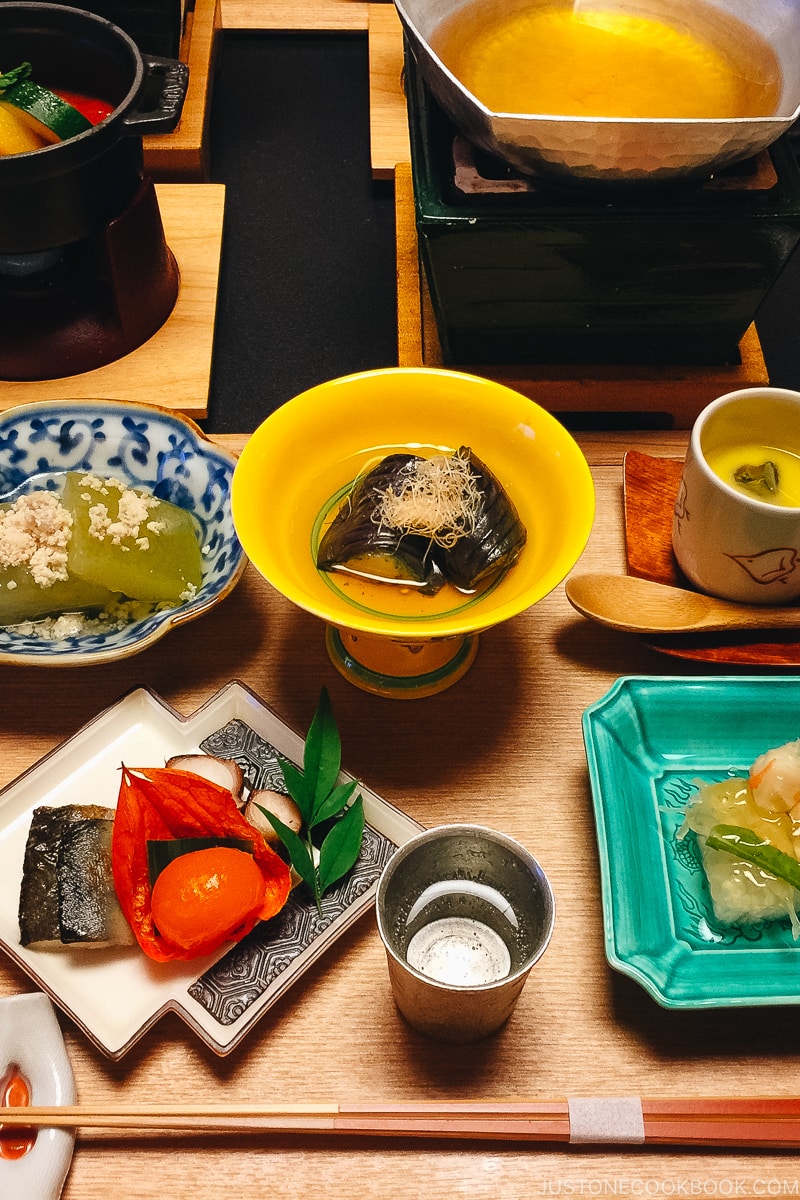
Far removed from the daily Japanese meal served at home, kaiseki ryori is described as Japanese haute cuisine that exemplifies the finest Japanese values—harmony, balance, and appreciation for craftsmanship. You may have heard or seen images of the elaborate ordeal. The masterful presentation of plated dishes, the nod to seasonal ingredients, and the exquisite spread of tableware. The tranquil setting and the most attentive hospitality.
At its core, kaiseki ryori celebrates the Japanese culinary world’s distinctive seasons and craftsmanship. It is a feast and a full-sensory experience, a must-try culinary experience for any visitor to Japan.
Table of Contents
What is Kaiseki Ryori?
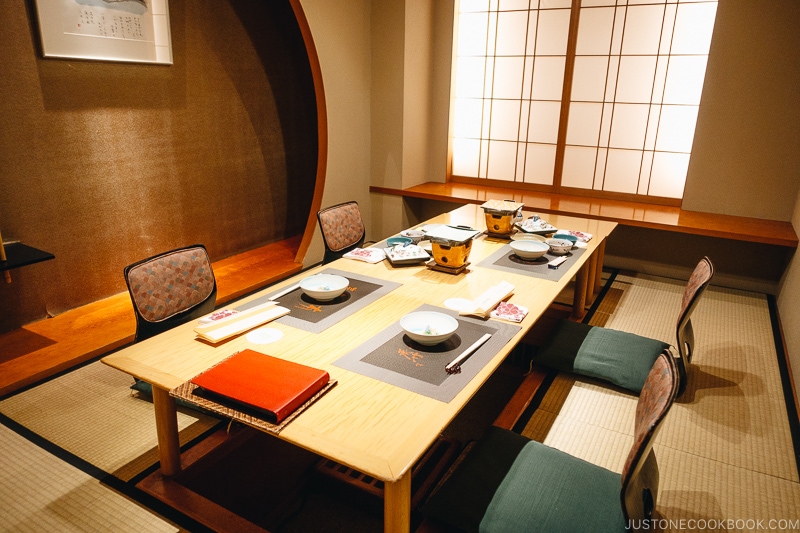
Kaiseki ryori is a traditional Japanese multi-course meal served at high-end Japanese restaurants and inns. The luxurious fine dining is typically reserved for special occasions.
The Origin of Kaiseki Ryori
In Japanese, “Kaiseki” can be written in two ways: 懐石 and 会席. “Ryori” (料理) means cooking, cookery, or cuisine. While confusingly noted in two different ways yet pronounced the same, it has two distinct meanings.
Kaiseki, written as 懐石, or cha-kaiseki (茶懐石), refers to a meal served at a Japanese tea ceremony, where Buddhist monks would carry warm stones on their stomachs to keep hunger at bay while fasting. The meal was simple and meditative.
The term became widespread during the Azuchi-Momoyama Period (1573-1603) by Senno Rikyu (千利休), the founder of the Japanese tea ceremony. Over time, it developed into a multi-course elaborate meal with intricate dining rules.
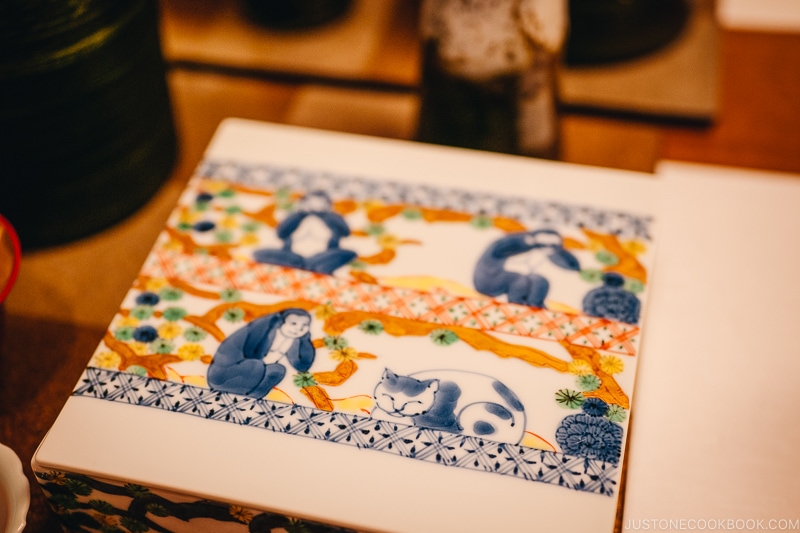
The latter ‘kaiseki,’ written as 会席, refers to a banquet dinner, often for a celebratory occasion. It is a condensed fusion of different dining styles initially reserved for the upper class and popularized among the merchant class during the Edo period (1603-1868). The kaiseki restaurants you encounter are most likely this style.
Kaiseki is a dinnertime affair, but some restaurants offer a shortened (and therefore cheaper) Kaiseki lunch.
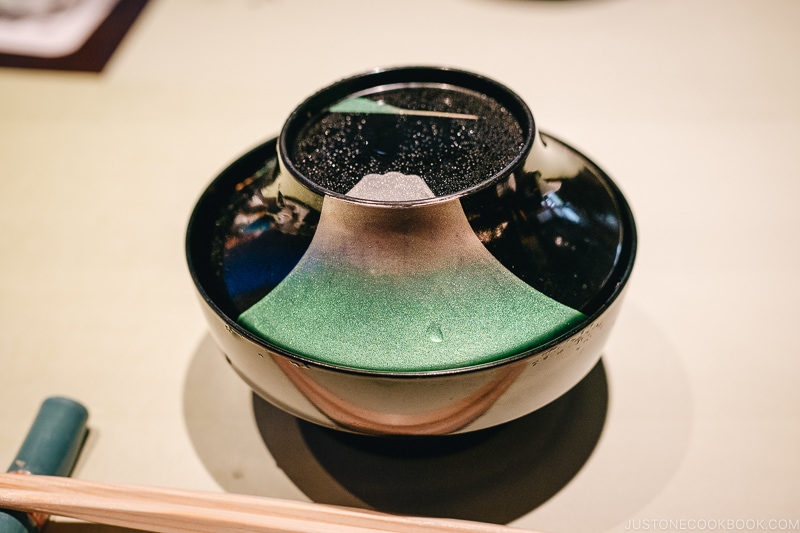
The Elements of Kaiseki Ryori
You can expect an all-embracing element of seasonality, culinary artistry, and hospitality at a kaiseki meal. Every dish is painstakingly prepared with the season’s freshest produce, with each ingredient carefully crafted to highlight its essence.
Everything surrounding the meal also emphasizes the same principles. The decorative leaves and vegetable cuts on the serving wares, the flowers furnishing the restaurant, the Japanese hanging scrolls, and the color scheme on the hostess’ kimono—each element is thoughtfully curated to complement the experience.
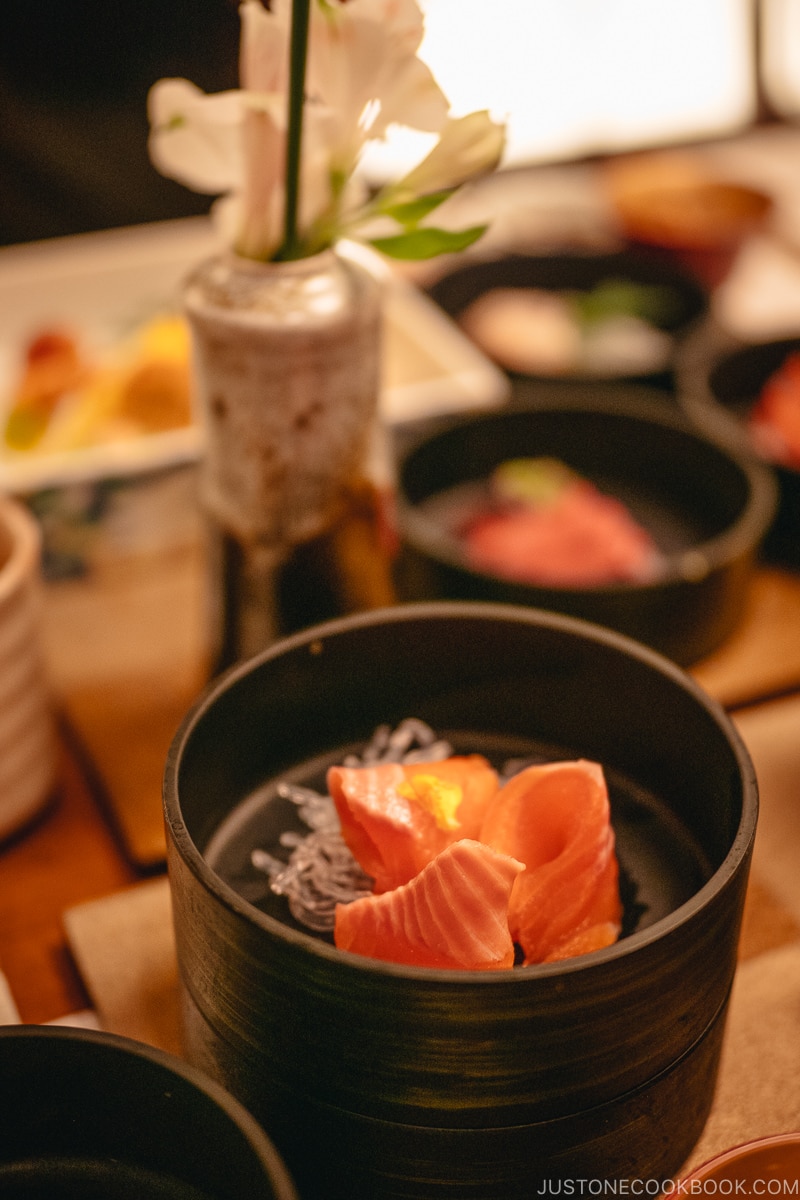
The restaurant ambiance also plays a big part. You may see motifs of plum or cherry blossoms during the spring, bamboo leaves and the Milky Way during the summer, autumn foliage during the fall, and snow during the winter.
As your meal progresses, take a few moments to absorb the curated environment surrounding you.
The Courses Served at Kaiseki Ryori
So, what’s in a kaiseki meal, and how many courses are served?
This article will focus on the banquet dinner Kaiseki (会席). Cha-Kaiseki follows a similar course distribution but differs in rituals depending on the tea ceremony schools.
At a kaiseki meal, the order of the dishes is mostly the same, although some restaurants may swap the order, and some may skip one or two courses. Each course is served one at a time, and portions are bite-sized. After clearing the food, a new dish will be served. Now, let’s take a look at what you may encounter.
The Starters
1. Sakizuke (先付):
Bite-sized appetizer, similar to an amuse-bouche.
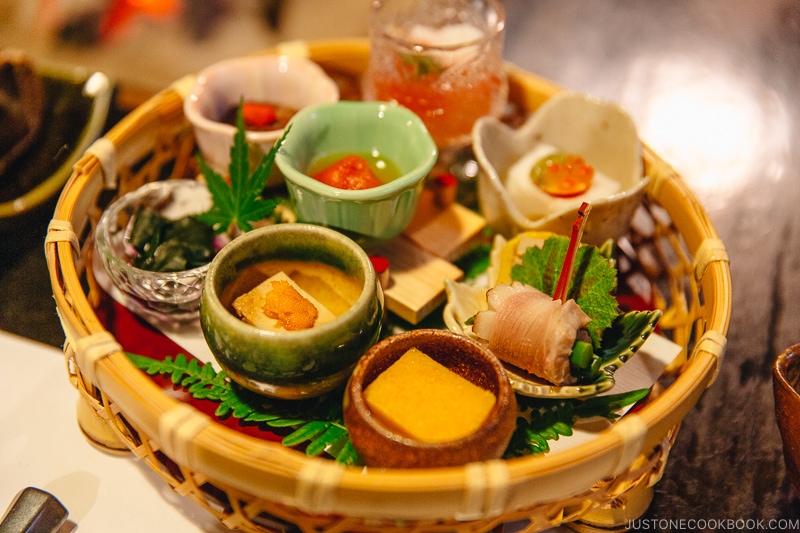
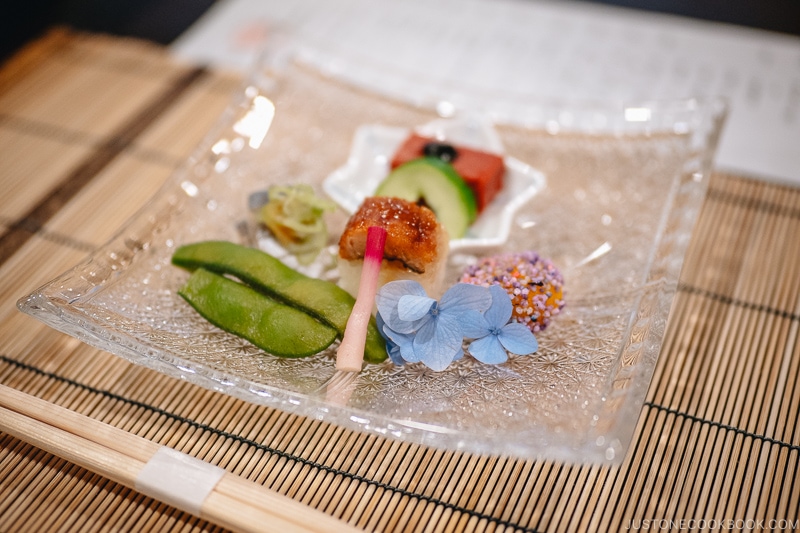
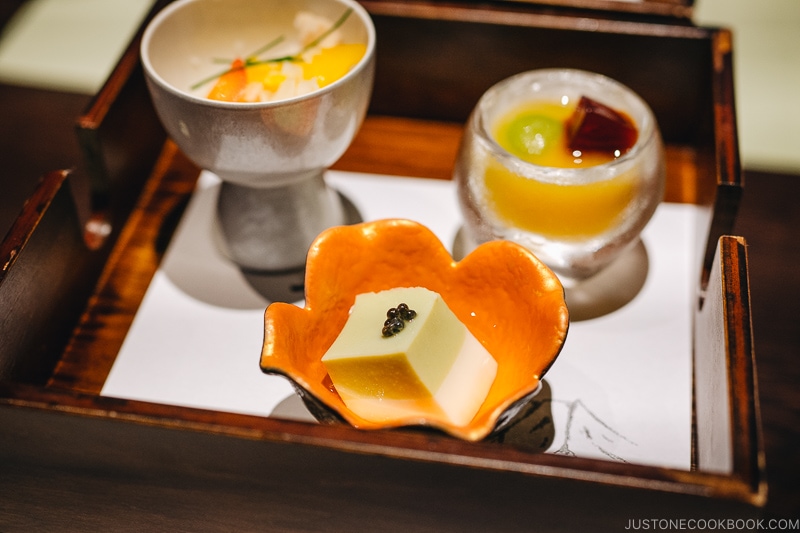
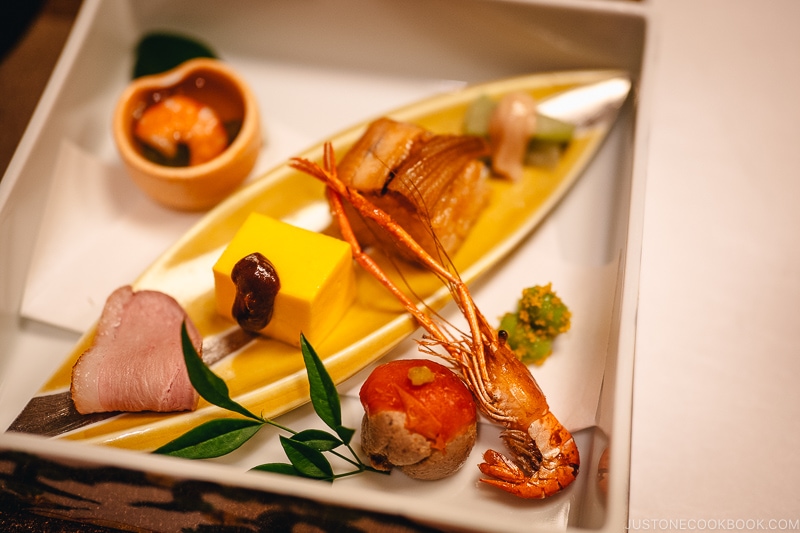
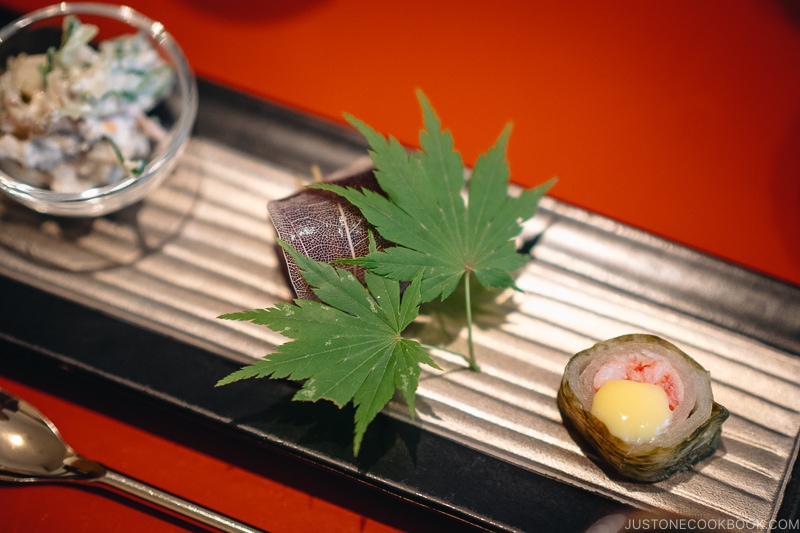
📝 Recipes: Tamago Tofu, Sweet Black Soybeans, Simmered Shrimp, Miso Glazed Eggplant, Koya Tofu.
2. Shokuzen-shu (食前酒):
An aperitif served with the Sakizuke, usually Sake (日本酒) or Umeshu (梅酒; plum wine). Some restaurants may offer non-traditional drinks such as sparkling wine or local beer.
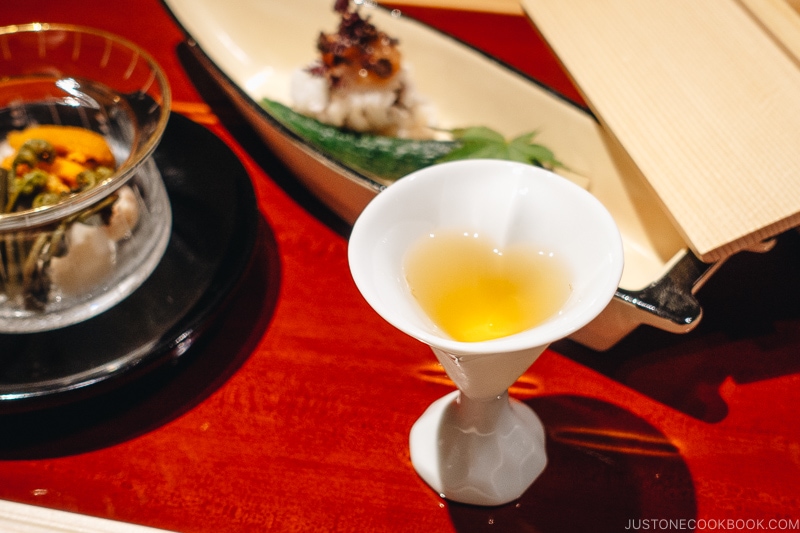
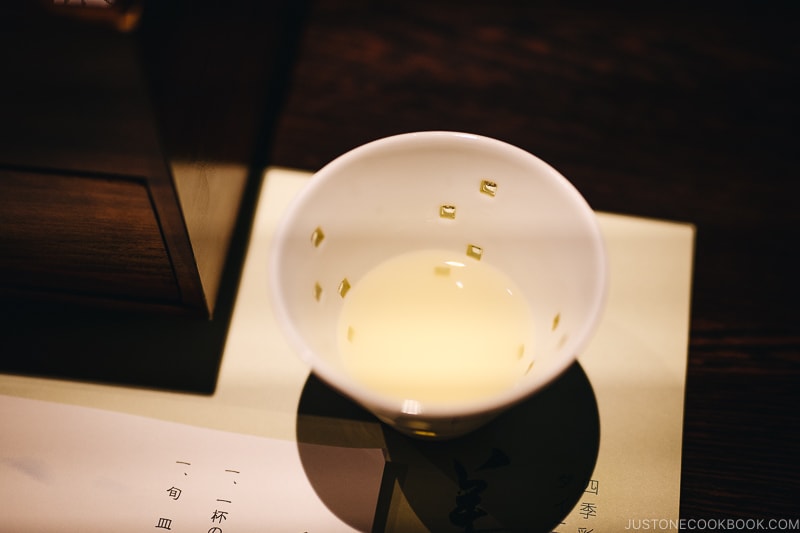
📝 Recipe: Umeshu (Plum Wine)
The Main Courses
1. Wan-mono/Owan (椀物/御椀):
Lightly seasoned soup for cleaning your palate.
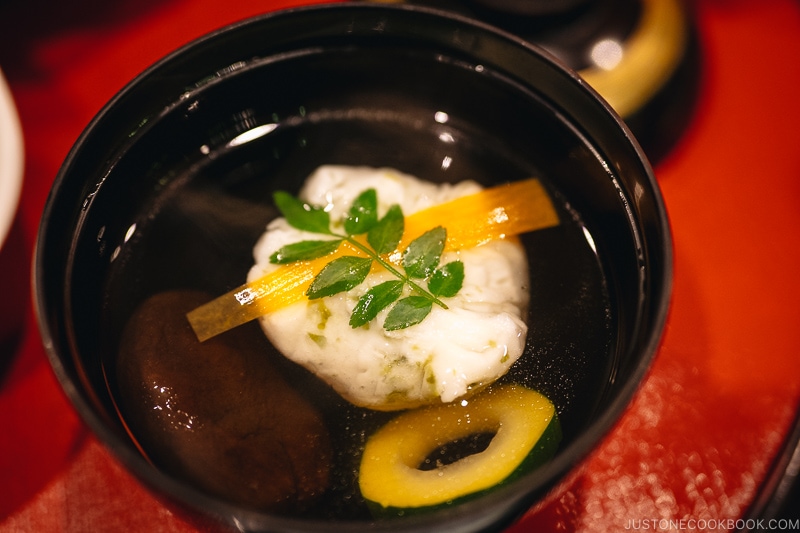
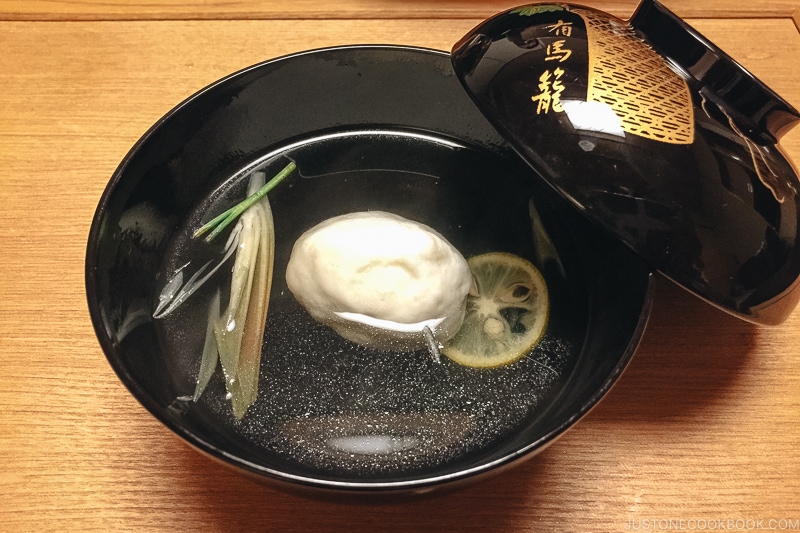
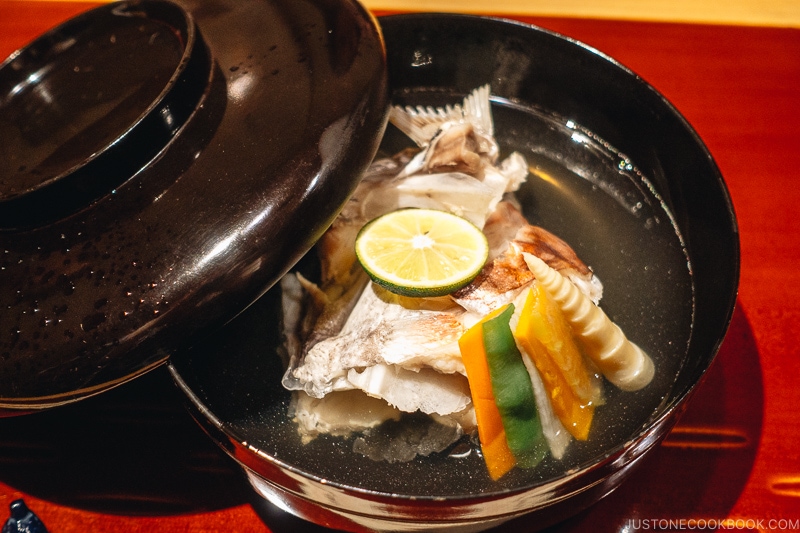
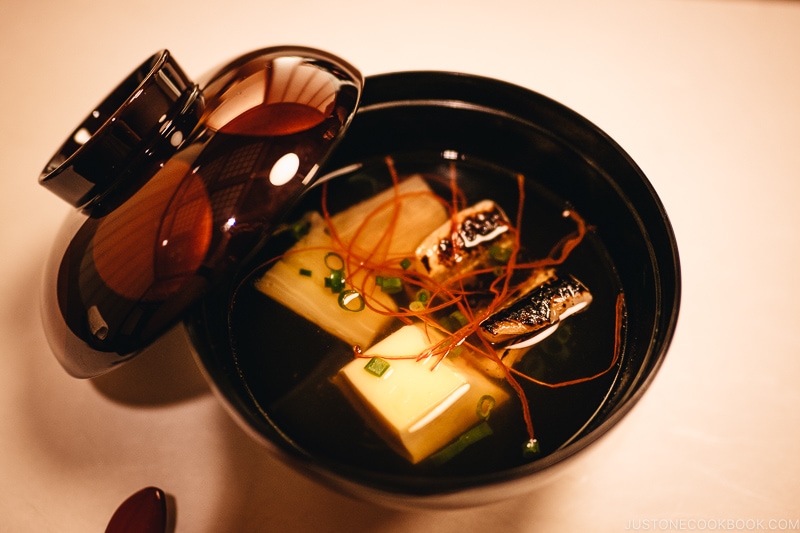
📝 Recipes: Clear Soup (Osumashi), Matsutake Suimono
2. Mukozuke (向付)/Otsukuri (お造り):
Selection of seasonal sashimi (slices of raw fish or seafood), usually 2~5 varieties. Some places may serve different types of soy or dipping sauce for each type of offering.
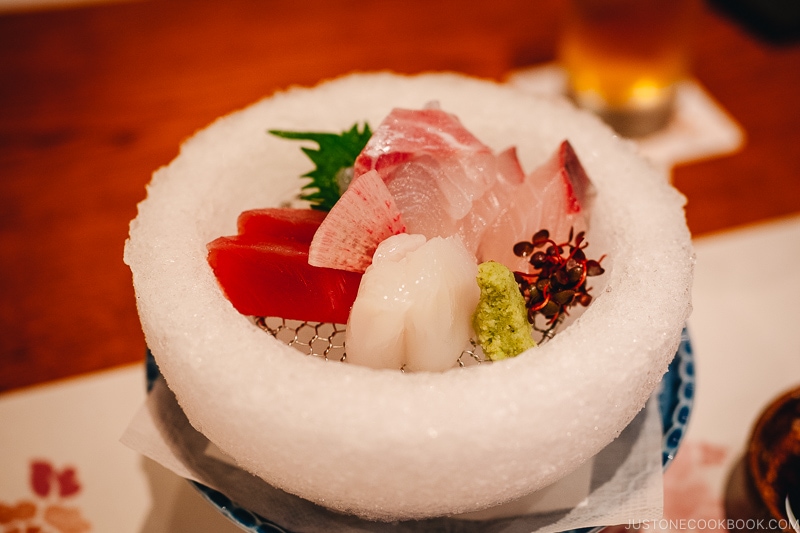
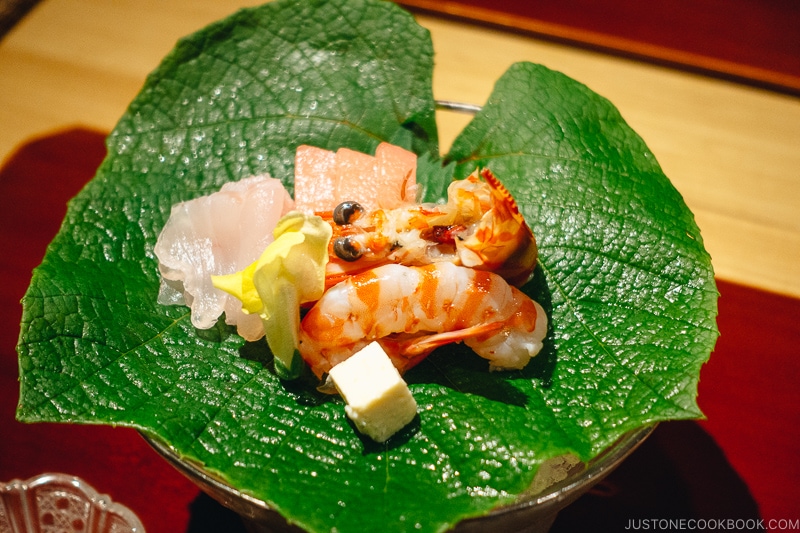
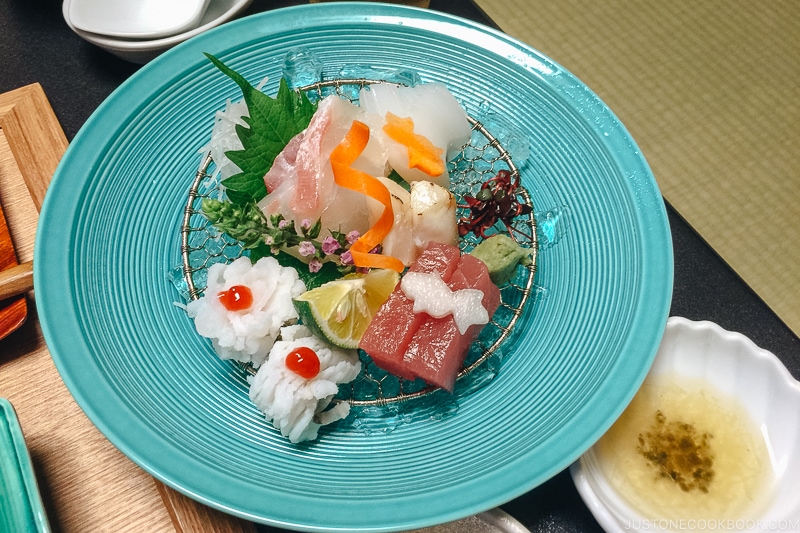
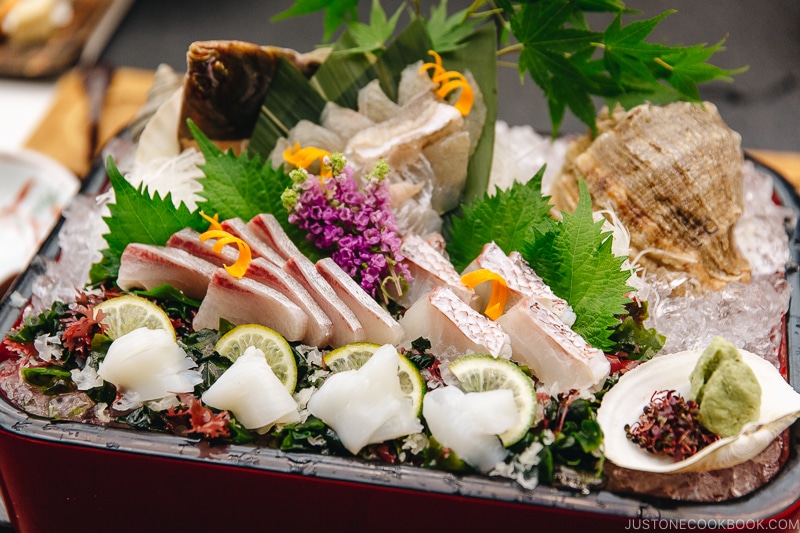
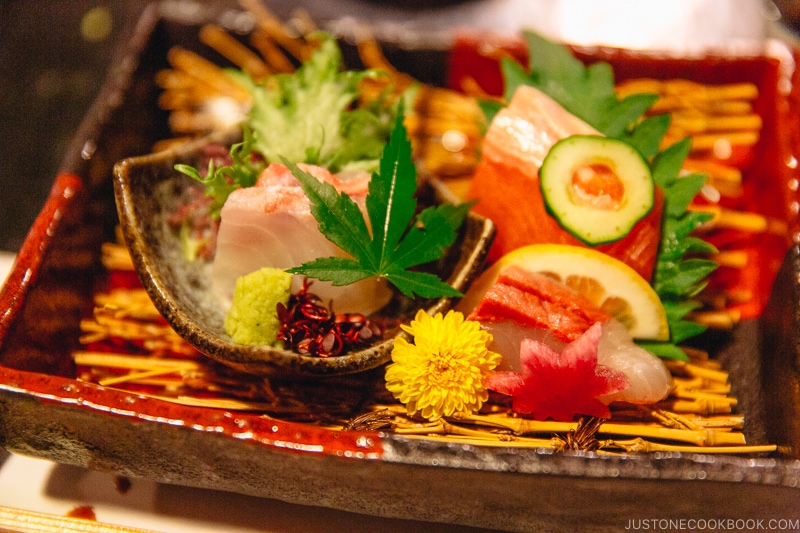
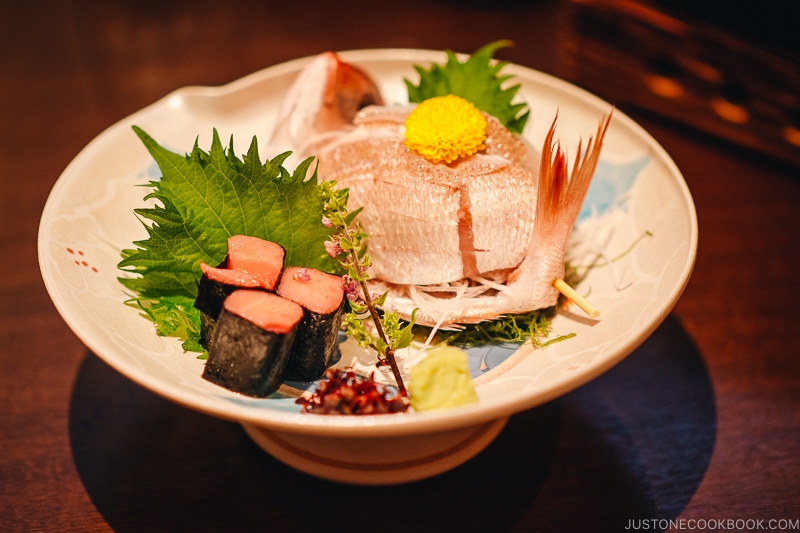
3. Hachizakana (鉢肴) or Yakimono (焼き物):
Features regional and seasonal fish, seafood, or meat.
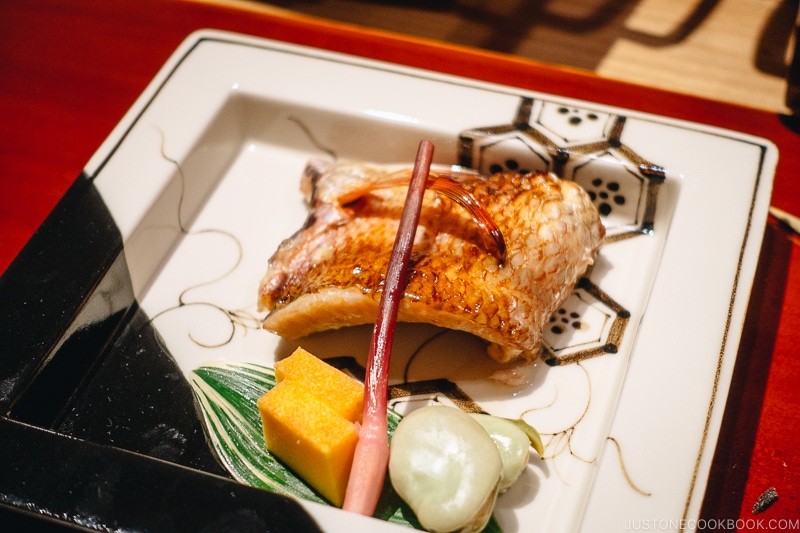
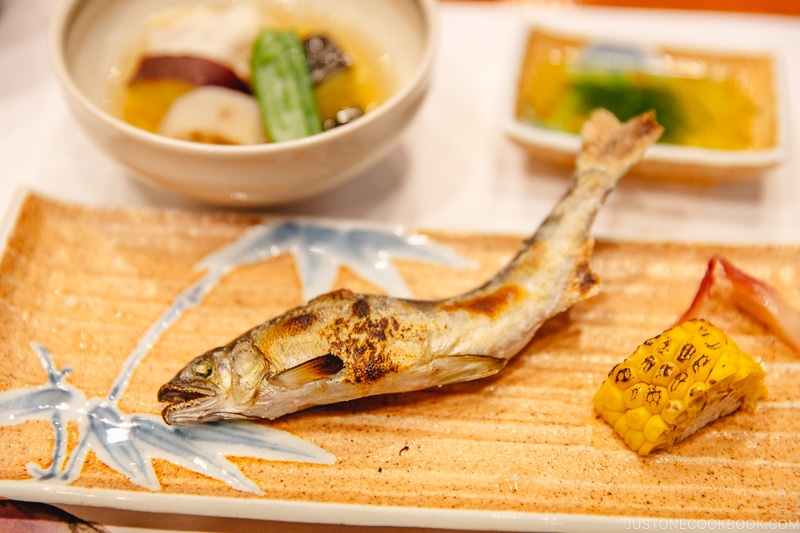
📝 Recipes: Miso Cod, Grilled Mackerel, Salted Salmon
4. Sunomono (酢物):
A light dish featuring seafood and vegetables in vinegar dressings. It serves as a palate cleanser.
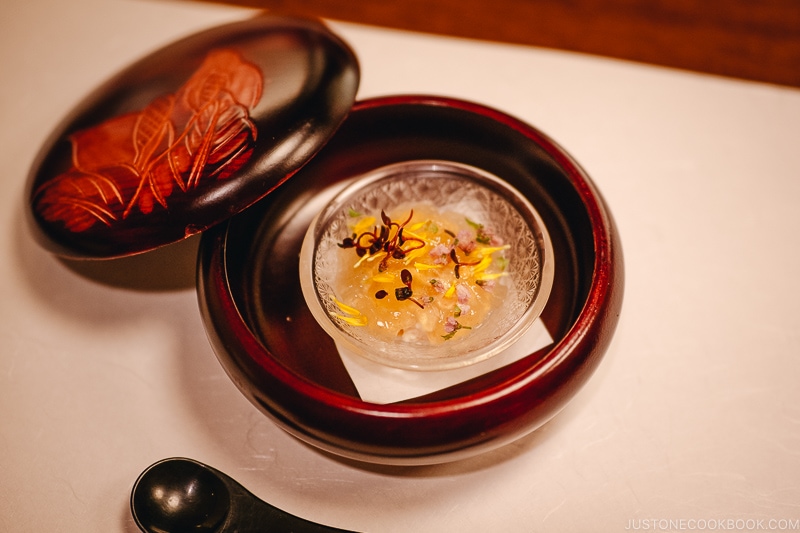
📝 Recipe: Sunomono
5. Shiizakana (強肴) or Takiawase (炊き合わせ) or Nimono (煮物):
A simmered dish that contains an assortment of vegetables along with protein. The ingredients are cooked separately to preserve their distinctive textures and colors and then put together on the plate.
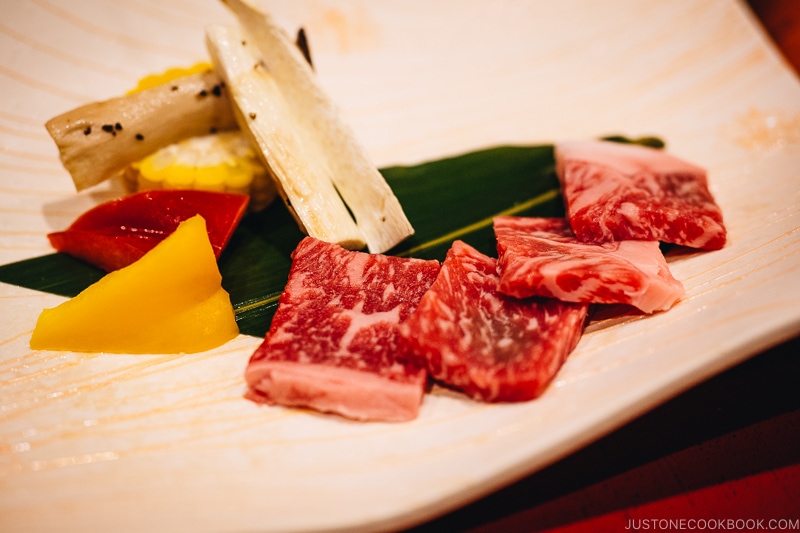
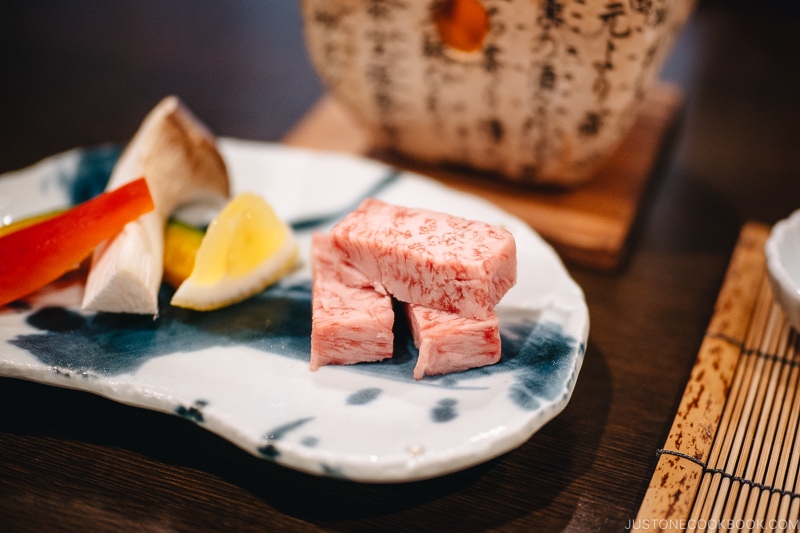
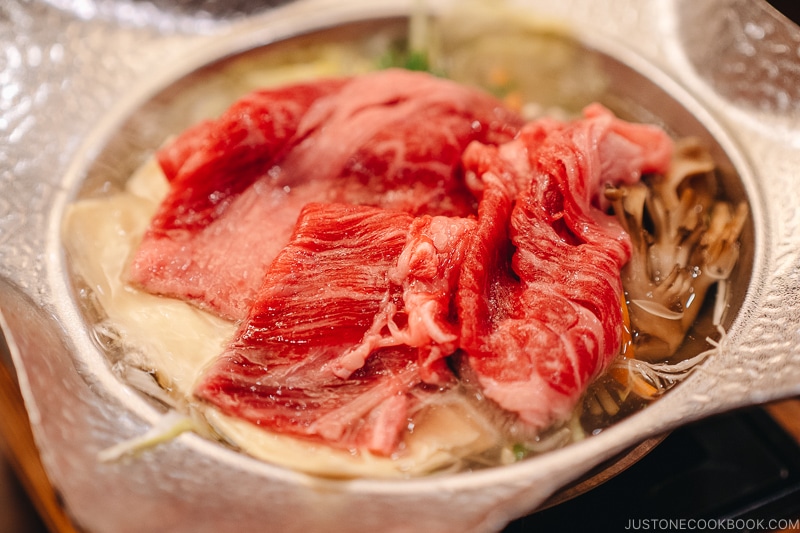
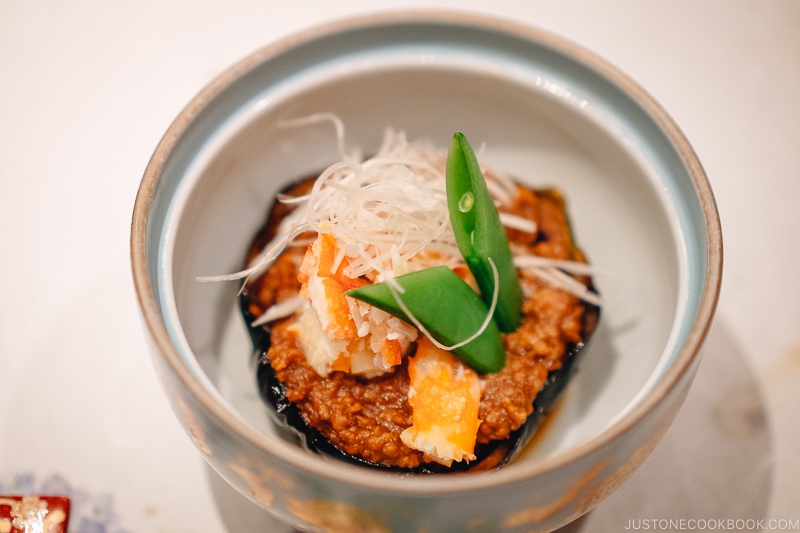
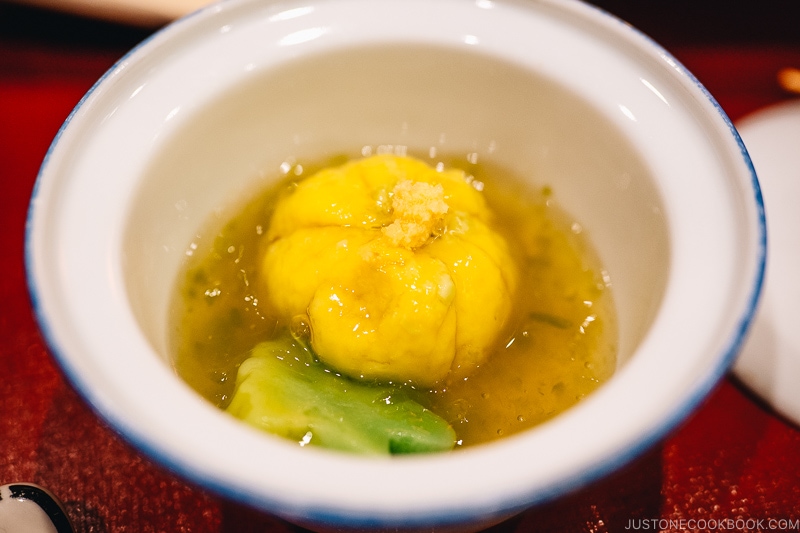
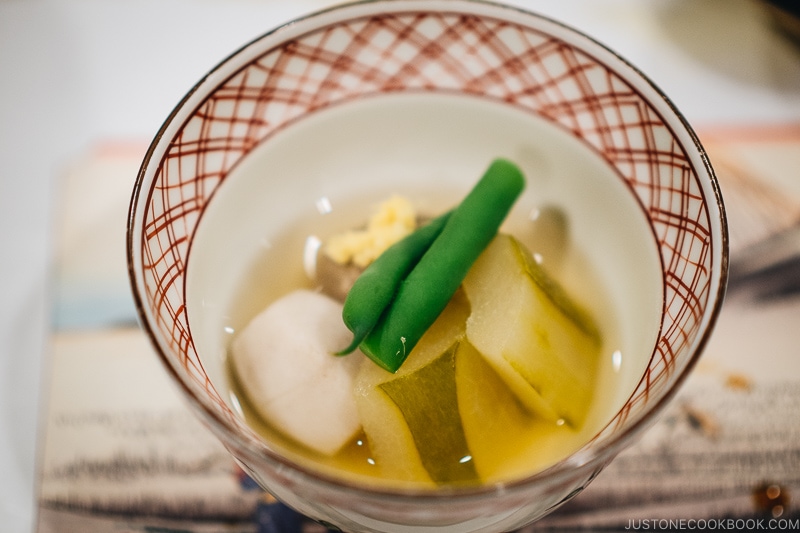
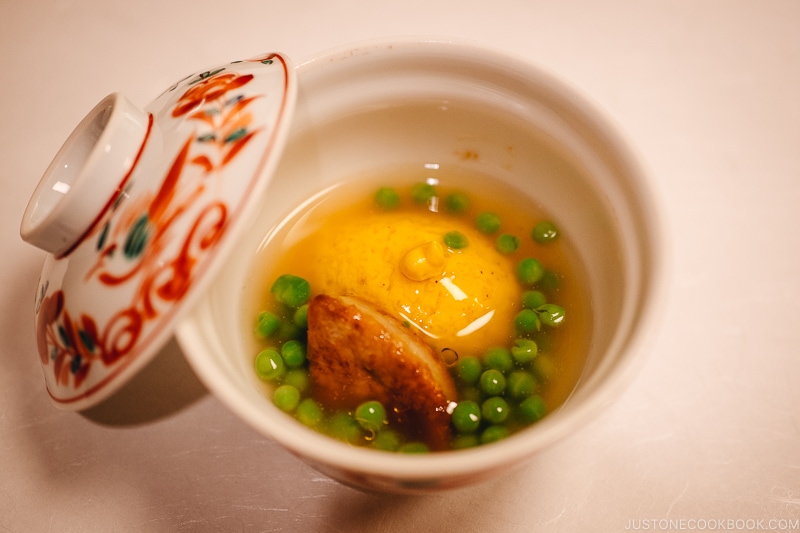
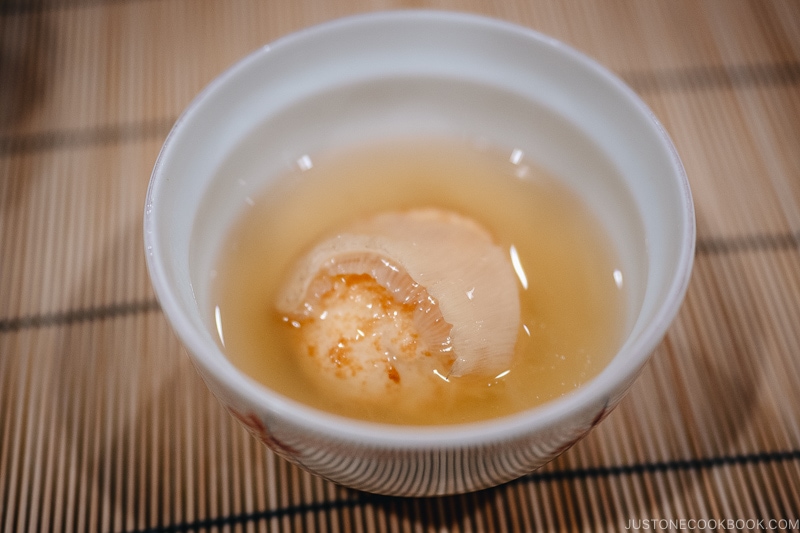
📝 Recipe: Hoba Yaki, Shabu Shabu, Sukiyaki, Simmered Beef and Tofu,
6. Agemono (揚物):
Usually, fried vegetables or fish. Some places may serve Tempura (天麩羅).
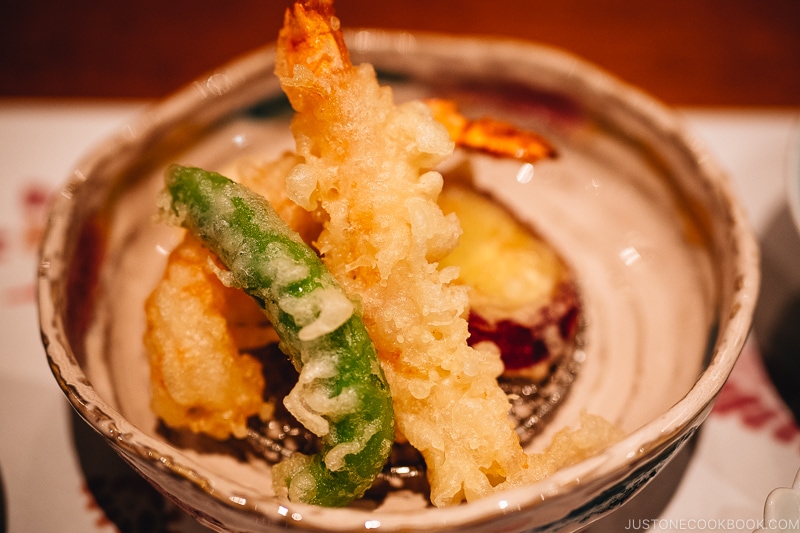
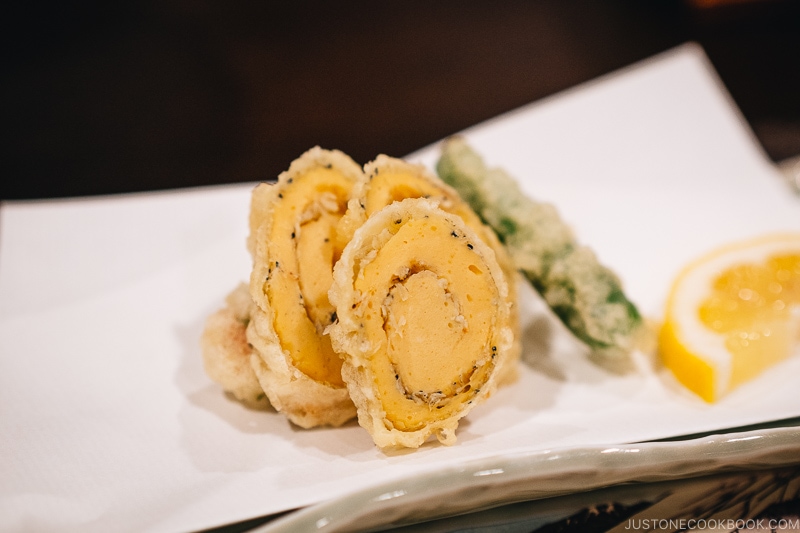
📝 Recipe: Tempura
7. Mushimono (蒸物):
A steamed dish such as Chawanmushi (茶碗蒸し; steamed egg custard), fish cakes, or root vegetables.
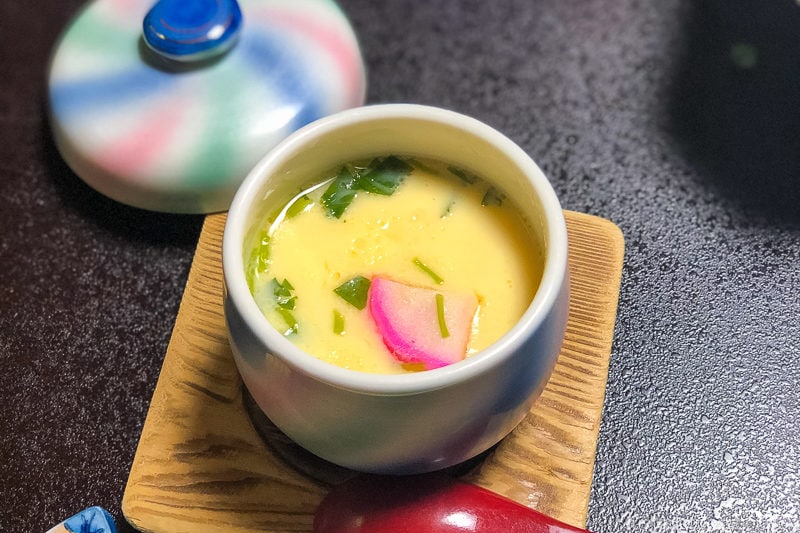
8. Oshokuji (御食事):
The last course before dessert. It features the foundation of a Japanese meal: rice (plain or seasoned), miso soup, and tsukemono (漬物; Japanese vegetable pickles).
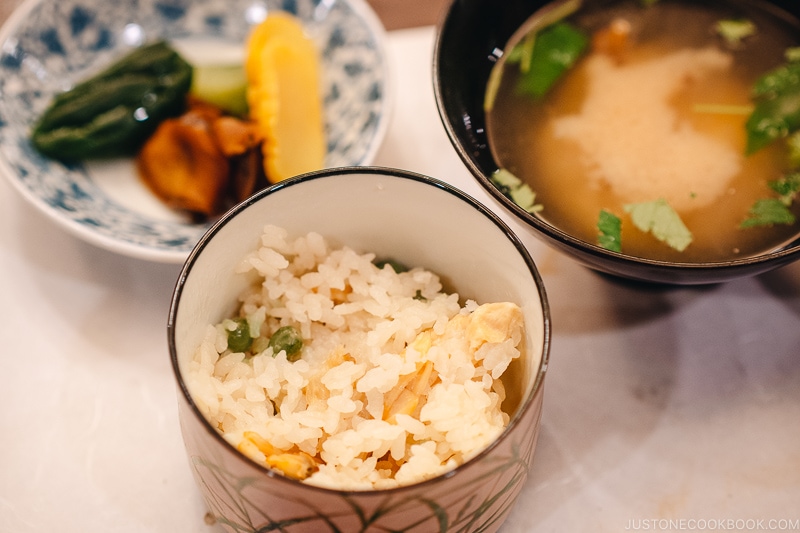
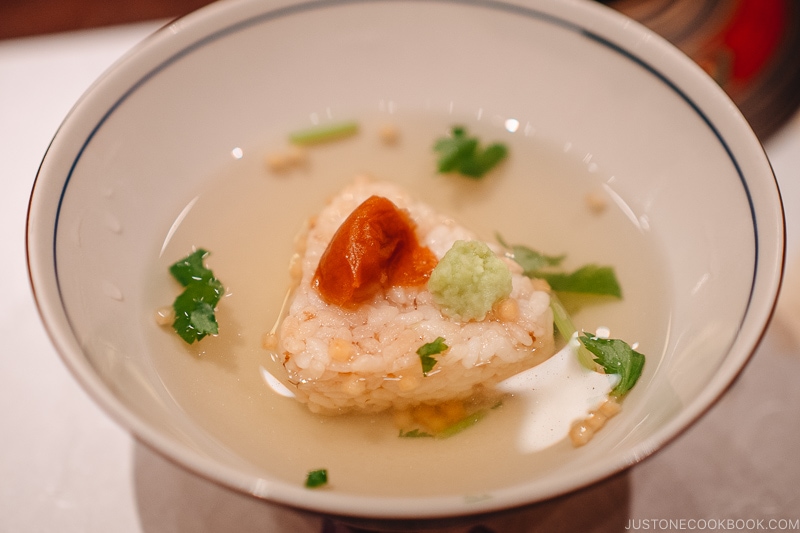
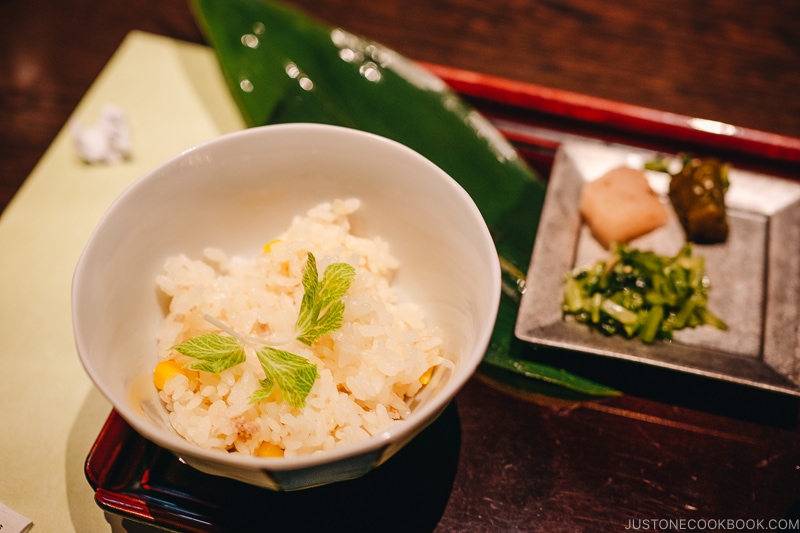
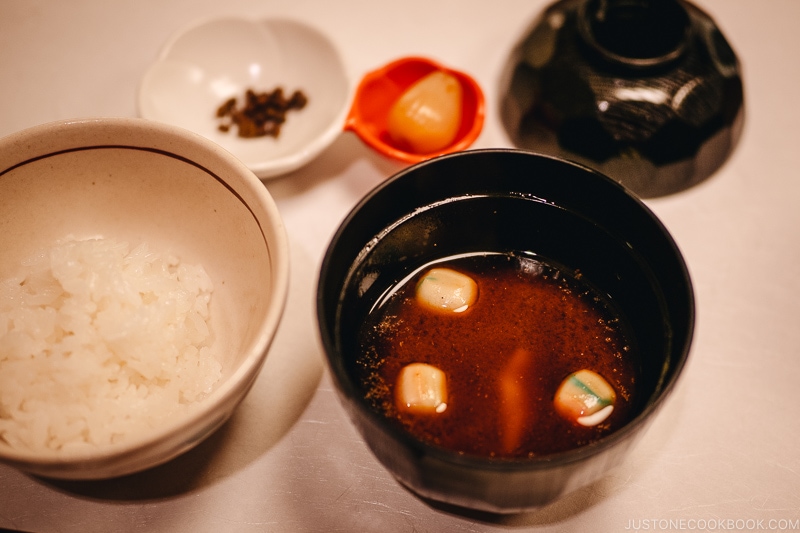
This miso soup is called Tomewan (留椀). It refers to the soup ending the meal to distinguish it from the earlier soup.
Your host/servers will stop serving you alcohol at this point as it is the signal ending your course.
📝 Recipes: Chestnut Rice, Corn Rice, Matsutake Gohan
The End of the Meal
Mizugashi (水菓子) or Kanmi (甘味):
A light fruit-based dessert. Some may serve cut fruit, and others may serve elaborate jelly, sherbet, wagashi (Japanese sweets), or cake. This last dish is usually served with hojicha (ほうじ茶 roasted green tea).
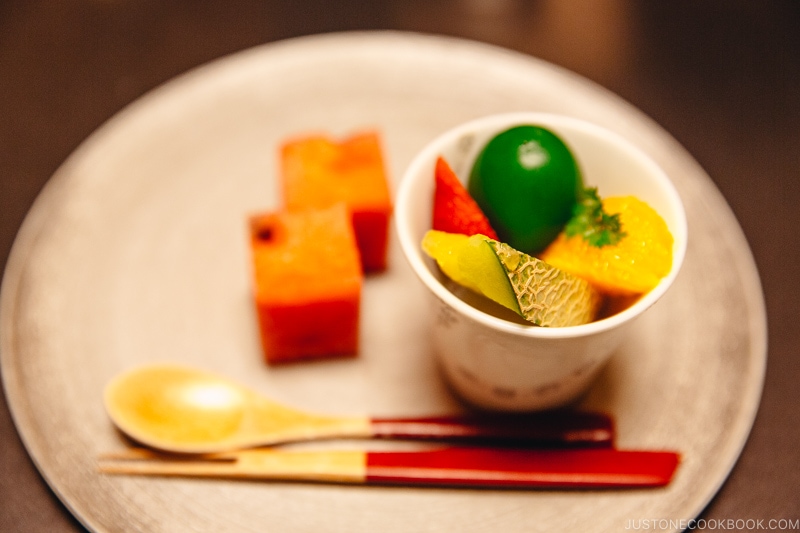
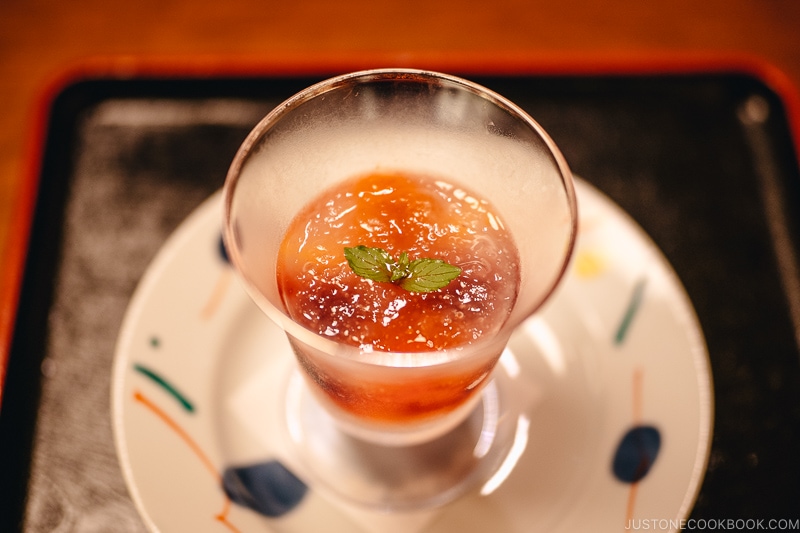
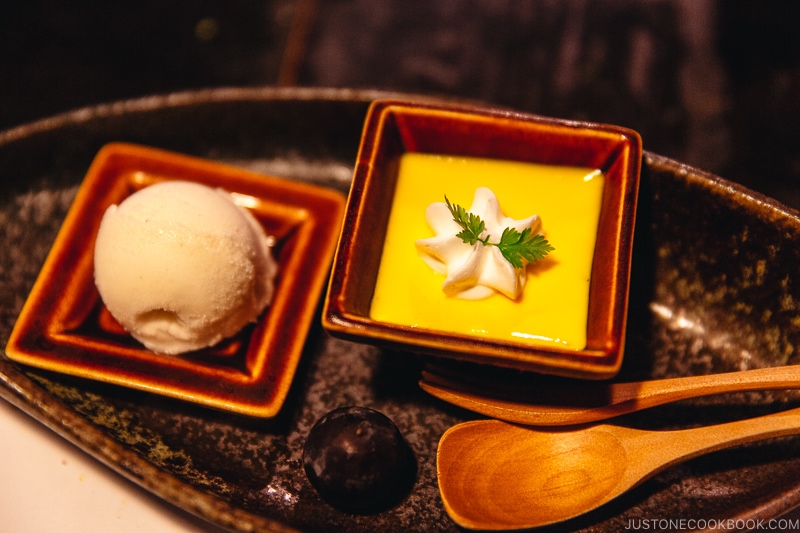
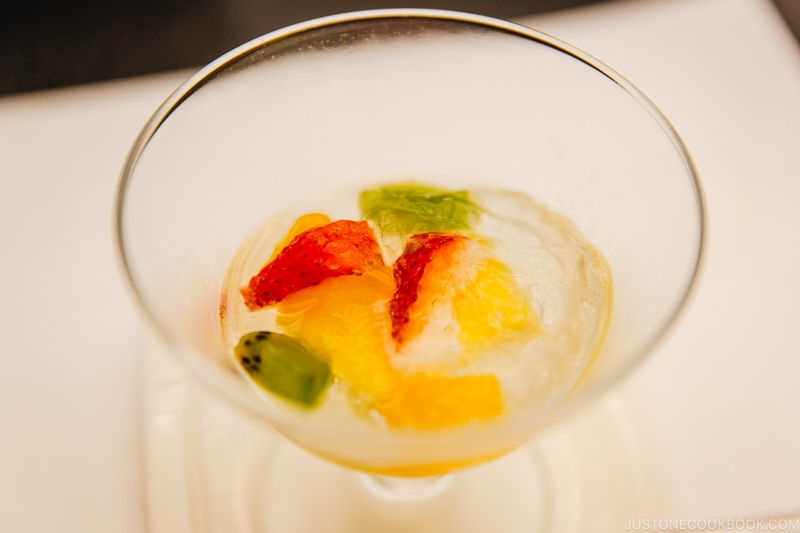
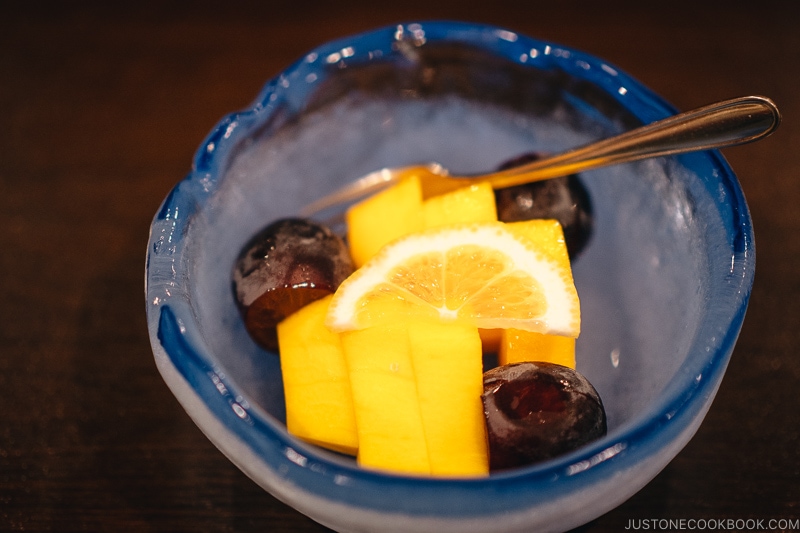
Seasonal Offerings
During winter, some restaurants may offer a hot pot course after the first few dishes, skipping the others entirely.
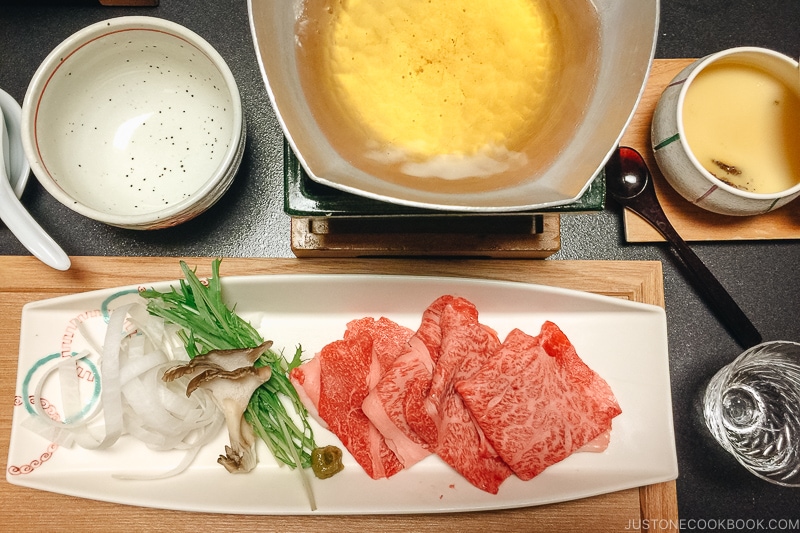
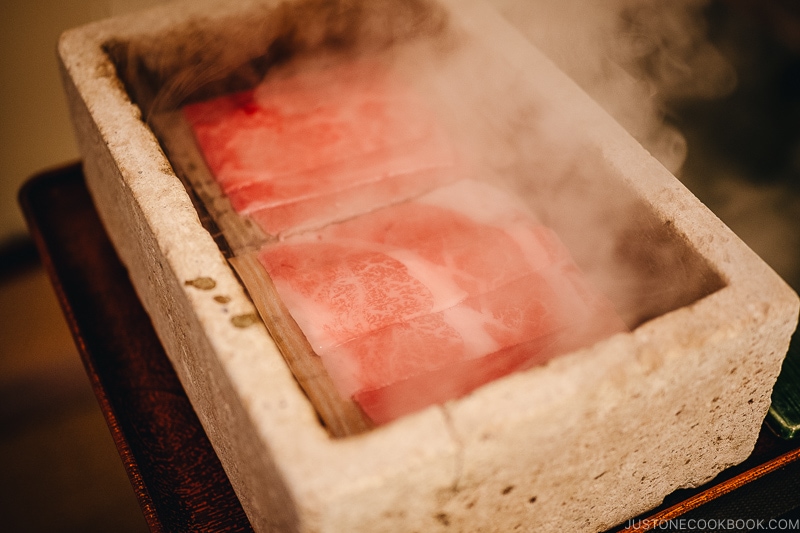
Areas famous for their local produce, such as beef, pork, or particular seafood, may serve a special course. For example, the JOC family enjoyed a Hida beef Teppanyaki course while traveling to Hida Takayama, a region famous for their black-haired Japanese cattle breed.
Dining Etiquette FAQs
Now, if you’ve made a reservation at a kaiseki restaurant and are excited to experience this unique dining, let’s learn the rules and etiquette beforehand. Here are some guidelines you could observe:
What should I wear? What should I avoid?
Treat a meal at a kaiseki restaurant like a 3-star Michelin restaurant. Wear clothing that’s comfortable but respectable to the place. You may be required to remove your shoes upon entry, so wear shoes that are easily slipped on/off. Walking barefoot on tatami mats is a big no-no, as your bare feet may rub the dirt and sweat into the tatami mats (and tatami mats are notoriously hard to clean!) Come wearing socks, stockings, or tights. If wearing slippers, take them off at the entrance of the room.
Avoid wearing cologne or perfume. It is said that strong smells are distracting to the chefs and your fellow guests.
If you’re dining at a ryokan (旅館; Japanese inn), you may be able to dine in the yukata (浴衣; cotton Japanese robes) supplied in your room. You may have your meal served in your room or in a dining room. Ask in advance if wearing a yukata outside of your room is acceptable.
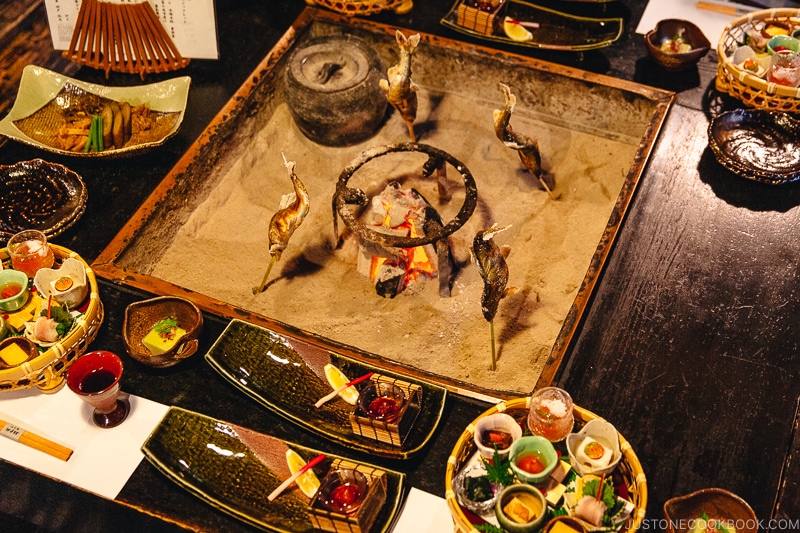
Can I take photos?
Ask the hostess or server if it’s okay to take photos. Most places would say yes, but no flash or photos of your fellow diners (to protect their privacy). Some chefs may be happy to snap a photo with you at the end of the meal, and some may not.
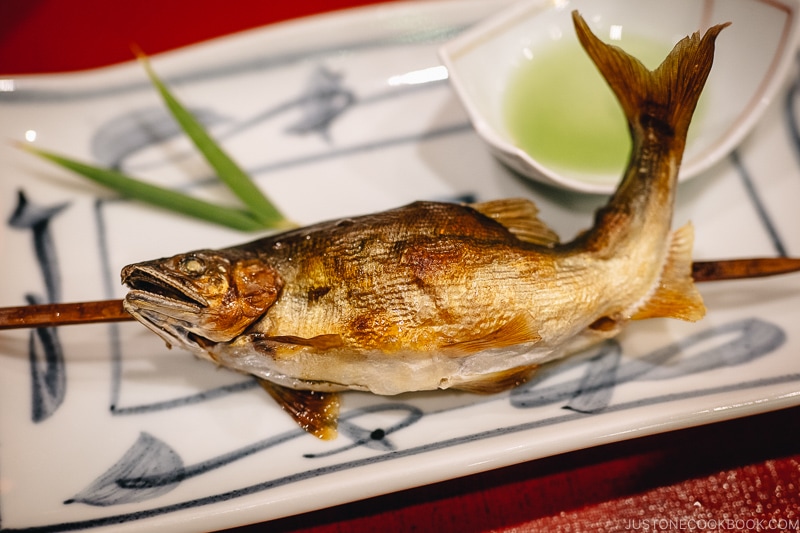
What are some of the dining etiquette I should be aware of?
This article on Japanese Dining Etiquette 101 and Part 2 should hopefully answer your questions regarding dining etiquette in Japan. Feel free to ask in the comment box below if you have more!
I have food restrictions (pescatarian/vegetarian/vegan, religious, food allergies).
Ask the restaurant before making a reservation, or check the website to see if they can accommodate your dietary needs. Unfortunately, many Japanese dishes contain fish and seafood products; this may be challenging for some.
For vegetarian/vegan diners, an option is to seek a shojin ryori (精進料理) restaurant (an upscale Buddhist cuisine that contains no animal or fish products). Halal-certified restaurants are rare, although some may be in touristy areas.
I don’t drink alcohol, but should I drink?
There’s no need to drink sake or alcohol with your meal, so don’t feel pressured because of the occasion! The restaurant may have non-alcoholic alternatives, but sticking to water or tea is also acceptable. Feel free to discuss with the staff about your drink preferences and options.
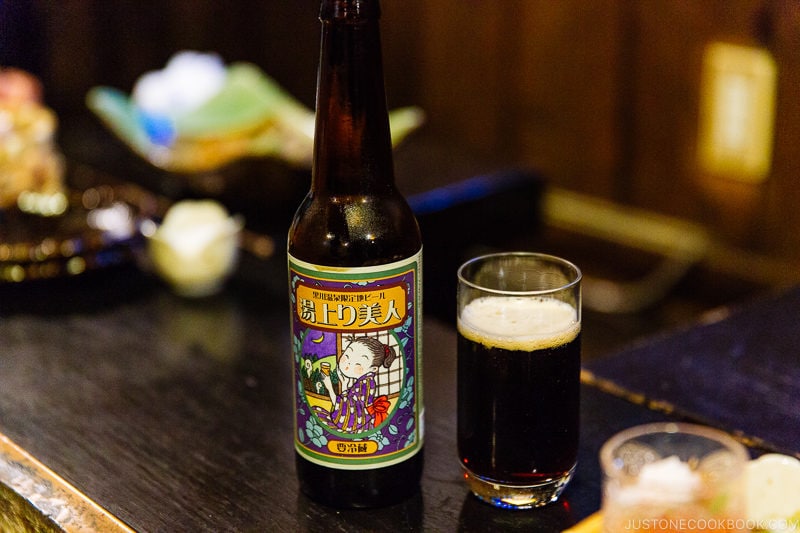
Can I pair the meal with alcohol other than sake?
Sake is a natural choice, but some restaurants have begun offering sparkling wine or craft beers for the first drink. Some may offer wine pairings. Ask your hostess for suggestions, and be open to exploring! Don’t be surprised if the restaurant doesn’t have a drink menu. Instead, tell the server what flavors you like (dry/sweet, light/full-bodied, chilled/room temperature/hot, etc).
Right before the last meal (oshokuji, お食事), your hostess/server will stop serving you alcohol. Traditionally, there’s no dessert alcohol/digestive equivalent for the dessert course, although some restaurants may have dessert wines, port, or brandy in stock.
Is tipping required or necessary?
Tipping is not commonplace in Japan. However, you may notice a “service charge” added to your bill, a practice seen at most high-end restaurants. This is typically stated on the restaurant website or at the bottom of the menu. Ask your hostess if you’re unsure.
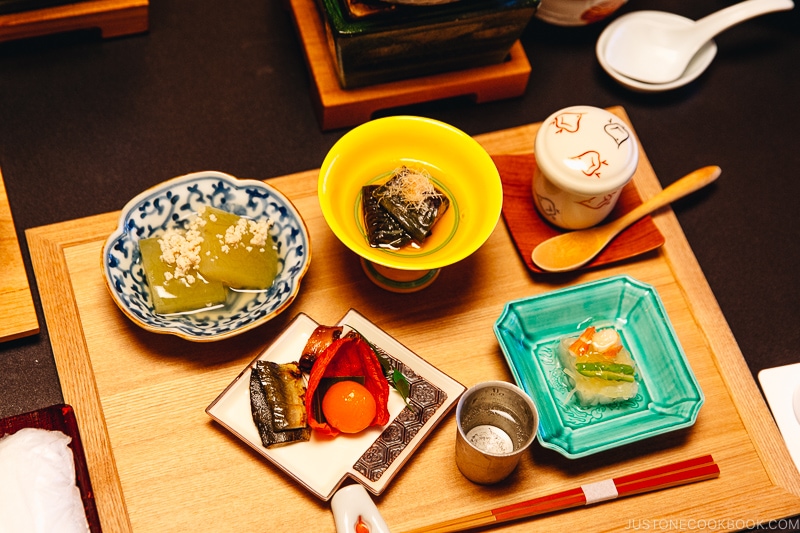
Where to Experience Kaiseki Ryori
Ready to dine at a kaiseki restaurant? In Japan, you’ll find many options in the big cities and the smaller towns. They range from world-renowned restaurants to local gems. Many of them are family-run and deeply steeped in local history. Conversely, others take a more modern interpretation of kaiseki. You may notice non-Japanese produce and tableware incorporated into these new styles of kaiseki.
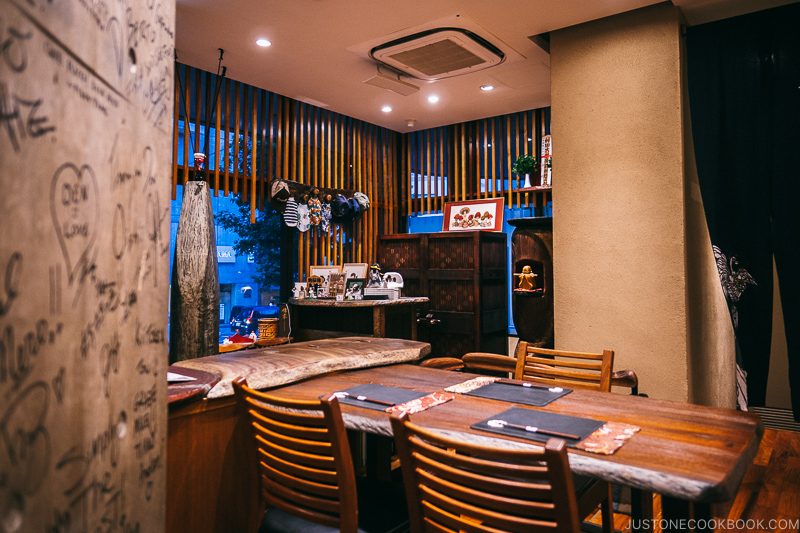
Regardless of where you dine, you should always make a reservation for the more popular restaurants, sometimes weeks or months in advance. Keep in mind that whether or not you drink alcohol, it will be a costly meal. If you’re curious but don’t want to shell out the big bucks, you can always try the shorter, wallet-friendly lunch course.
Many Japanese inns (ryokan, 旅館) offer a kaiseki course for dinner. The cost is included in the room or added on as a surcharge. You can also scout for restaurants with the titles Ryotei (料亭) or Kappo (割烹) attached. Ryotei is an exclusive restaurant where traditional entertainers called Geisha (芸者) or Maiko (舞妓) perform for the customers. Kappo is a counter-seating restaurant.
The JOC family has featured their kaiseki restaurant experiences on the blog, such as Den in Tokyo, Wakuriya in San Mateo, and Kyo-Arashiyama Nishiki in Kyoto.
You can also use Table All, an English online booking service for high-end restaurants in Japan.
Have you dined at a Kaiseki restaurant before? We’d love to hear your recommendations and experience!
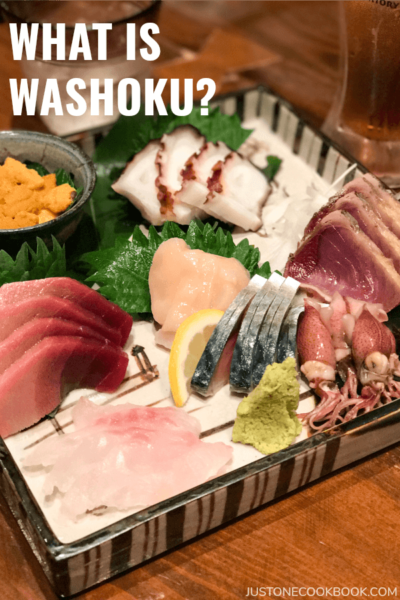
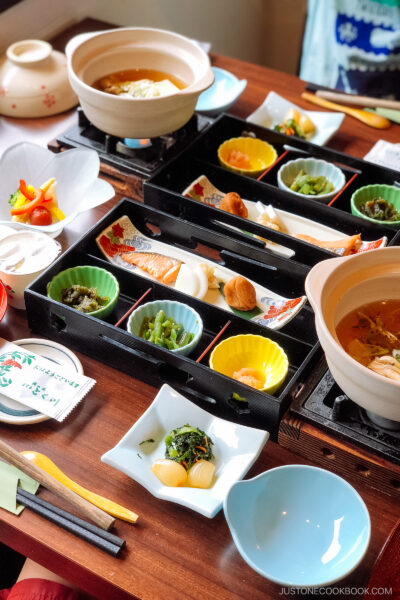
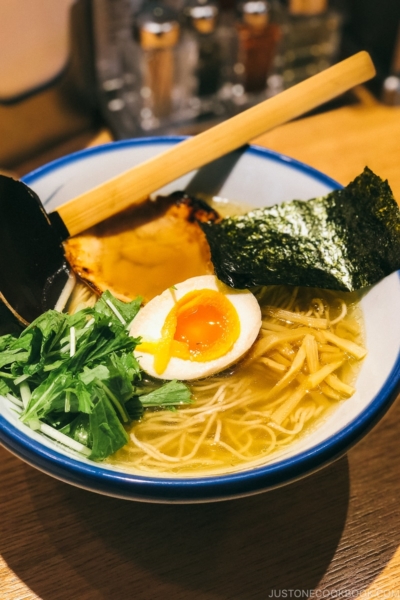





I had the immense pleasure to have a kaiseki meal at a local restaurant and it was a truly magical experience with seasonal foods and thoughtful wine & sake pairings. I have also enjoyed smaller/shorter kaiseki style meals and I hope to make it to one each season one of these years to learn about and enjoy the seasonal delicacies prepared by the chefs.
Thank you for the informative article!
Hi Megan, thanks for your comment! I hope you’re able to visit Japan throughout the different seasons to experience Kaiseki cuisine 🙂
Thank you for this overview and the wonderful recipes on your website. I made an attempt at making a Kaiseki Ryori menu and had a blast making it all (and eating it of course :-))
Hi Jelle, thank you for reading! That is fantastic that you made a kaiseki meal at home! I’m sure your fellow diners enjoyed the experience as well 🙂
Hi there. I love this website and I really love this article. It would be amazing to try to prepare a Kaiseki meal for a special occasion at some point for friends or family. I am just afraid I would fail to capture the seasonal wonder of the experience by picking the wrong dishes. Do you have any suggested menus, with courses that really compliment each other? Like, if I started out with Gyuniku Negimaki or Kani Kyuri Ikomi, what would be some suitable dishes to build off there? (And for that matter, would the Gyukinu Negimaki be more suitable for for the Yakimono course?)
Anyway, a suggested menu set would be nice.
Hi William, thank you for reading. Preparing a kaiseki menu would be a huge surprise for your friends and family! We don’t have a suggested menu on JOC because it’s rarely prepared at home. But I don’t think you should be caught up on failing to capture the seasonal wonders or getting it wrong. It would be a festive occasion and like a Thanksgiving or Christmas meal, it’s all about getting together and enjoying the meal, so I don’t think it’s necessary to be worried about pairings. Good luck with your endeavour!
Are Kaiseki Restaurants kid friendly?
Hi Dona! To respond to your question, it depends on the restaurant and ultimately how old you child/ren are. Similar to a Michelin starred restaurant, Kaiseki restaurants rarely offers a children’s menu and may not cater to young patrons. You can always try asking the restaurant to be sure. The Kaiseki restaurants in Japanese inns often has a children’s menu, so if you’re curious to try Kaiseki this may be an option. -Kayoko
Thanks Nami-san. Great writeup. I’m so happy that there are some authentic options close to home. Wakuriya here we come! ありがとう。
Hello Bill! This is Kayoko, the author of this article. Thank you so much for your comment! Hope you enjoy your experience at Wakuriya, I’ve never been but hear good things about it. Cheers! -Kayoko
Hello Kayoko – thank you for a wonderful article ! A lot of memories for me ! Am writing from Australia where for quite some decades my husband’s family was involved in the plastics business. Becoming a company director in the various companies in my early twenties I had the immense good fortune to visit Japan over 30 times in a couple of decades. Initially totally ignorant but appreciative especially as far as food was concerned. Had little knowledge about kaiseki ryori meals or anything similar but I know we were feted in the most famous Japanese restaurants of this style literally hundreds of times during that era. Your story is so very familiar. In a way I wish this was happening now where prior tuition is so easily available. We began taking our daughters to Japan from the age of about 3 – they loved their meals being served in style in the private ryokan rooms . . .I think we all would have loved to live in Kyoto. Reading your fab writing and looking at the photos I so remember but also cringe wondering what terrible faux pas I inevitably committed 🙂 ! Thank you !
Hi Eha! Thanks for your comment 🙂
Very jealous to hear that you were able to experience fine dining many times, more than the faux pas it’s more important (I think) that you were able to appreciate the food and the atmosphere! Hope your daughters enjoy the food and their time in Japan, I can only imagine the excitement of dining in one’s own room at a Ryokan! Kaiseki is an experience not many of us Japanese folks get to partake as well, and I’m sure I’ve caused my own oops moments… Researching this topic definitely helped me brush up my knowledge! Please stay tuned for my future articles! Best, Kayoko
Thank you so much 🙂 ! Oh I shall ‘stay tuned’ ! Methinks my girls loved the ryokan food experiences so much because they felt no one was watching them trying something strange ! Hmm: I had to stop both from showing off more than once back home !! My worst ‘oops’ came at one of Tokyo’s main rail stations when the Managing Director and General Manager of one of the largest plastics manufacturing concerns both came to wish our whole family an enjoyable few days in Nara/Kyoto. Well – I knew to bow back, didn’t I ! But that the other person then bowed back a little lower ! Methinks my bows had almost reached my knees when something made me stop: stupid Westerner, I know !! The poor polite Managing Director had probably neve bowed so low . . to me !!!!!
Lovely article, but it failed to deliver on its promise of etiquette tips.
I wanted to know the proper way to eat these elaborate dishes. Many have broth.
When to drink from the bowls and when not to. When to lift the bowls and eat it while holding the bowels a nd when to leave them on the table.
After every picture of beautiful food perhaps instructions on how to eat it properly would accompany it in the future?
Thank you.
Hello Theophilus, thank you for your feedback.
This is an introductory post on Kaiseki, so I understand that it was not able to address all the topics that may arise. As for how to eat the dishes and what to lift, have you read my post on “Japanese Dining Etiquette 101” Topic #3? It mentions which bowls and plates that can be lifted, including bowls with broths and liquids.
As for your question regarding how to eat each dish properly, there is no “proper” way per se, assuming that the diner comes equipped with common sense (as for the chopsticks and Japanese cultural etiquette, most addressed in Parts 1 and 2 of the Dining Etiquette guide). Please let me know if you have specific questions, and I’ll do my best to answer them! -Kayoko
Hey Nami! Kaiseki is definitely amazing and a wonderful treat. I’ve only ever had Kaiseki at N/Naka in LA and I was left feeling satisfied yet wanting more. The three months advance reservation was incredibly difficult to get and of the few times I’ve tried with my boyfriend, we’ve only been able to reserve twice. I would love to try Kaiseki in Japan. I’ll remember those you’ve listed so I can hit them up!
Hello Erica! This is Kayoko, contributing writer for JOC. Thanks for your comment!
I’m jealous that you were able to dine at N/Naka twice! You’ll find Kaiseki restaurants across Japan, so hopefully you’ll be able to dine at one, whether a restaurant or in your hotel. Hope you enjoy 🙂
– Kayoko